Abstract
This paper focuses on firm’s R&D activities in autonomous vehicles. Using patent information with patent map and HITS algorithm, we demonstrate in this paper that R&D patterns of automobile manufacturers, parts suppliers and ICT companies. First, our patent map shows increasing R&D activities of autonomous vehicles along with development of artificial intelligence (AI) technology in recent years. Second, regarding to the levels of autonomous vehicles technology, HITS algorithm shows activities of autonomous vehicles development changes from Lv.0 through Lv.5. Third, since the year 2000, R&D activities of 3D241 in these three industries are lively. Fourth, using HITS algorithm, we find that most of the top thirty companies of automotive driving patent ranking are automotive manufacturers. Fifth, since in the late 1990s, R&D activities in automotive suppliers and ICT companies are lively. Finally, R&D activities in ICT companies once have declined, but since 2015, R&D activities in ICT companies are lively.
Keywords: Autonomous vehiclesR&D activitiesautomobile manufacturersparts suppliersICT companies patent information
Introduction
R&D activities in autonomous vehicles are increasing in the world, so autonomous vehicle technology concern to international competitiveness. Autonomous vehicles are products of the highly developed computer science, such as AI. So, strategy of these companies will concern to autonomous vehicle technology. So, CASE is a topic of automotive manufacturers, automotive suppliers, and ICT companies. R&D activities in autonomous vehicles are increasing in the world. Autonomous vehicles consist of autonomous recognition, judgment, and operation. According to NHTSA and SAE (the National Highway Traffic Safety Administration and Society of Automotive Engineers) autonomous vehicle is classified under six levels (Lv.0 through Lv.5.) Lv.0 is completely human operated vehicles, and Lv.5 is fully autonomous vehicles. So, we can find the changes of R&D activities by analyzing the changes of patent information. Specifically, we classify these companies as automotive manufacturers, automotive suppliers, and ICT companies. And using patent map, we analyze and consider R&D activities in these companies. In addition, we analyze the core technologies by using HITS algorithm, and analyze the trend of core technologies of autonomous vehicle technology.
Problem Statement
Overview of Automobile Industry
In the automotive industry, CASE which is initials of connected, autonomous car, sharing and electric vehicle has been focused. Above all, autonomous driving is rapidly developing technology by the reason of improvement of computer science. The sales amount of the world's automakers is shown in Figure
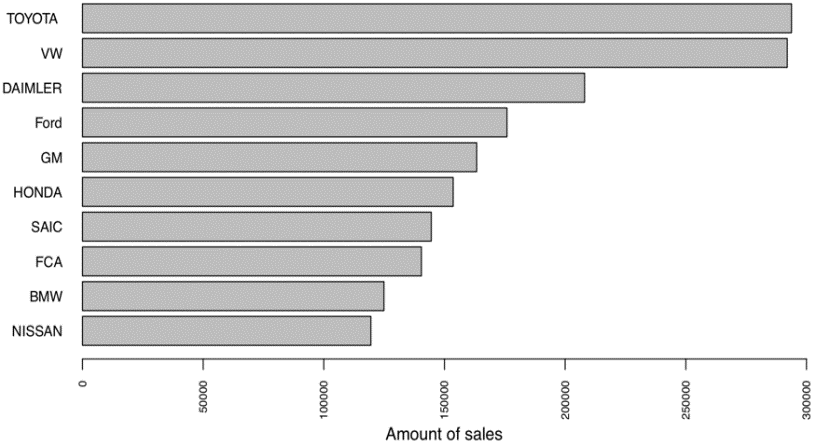
Overview of Autonomous Vehicles Industry
Definition of Autonomous Driving and Entry Companies
A definition of the autonomous driving levels proposed by SAE (Society of Automotive Engineers) in U.S. is shown in Figure
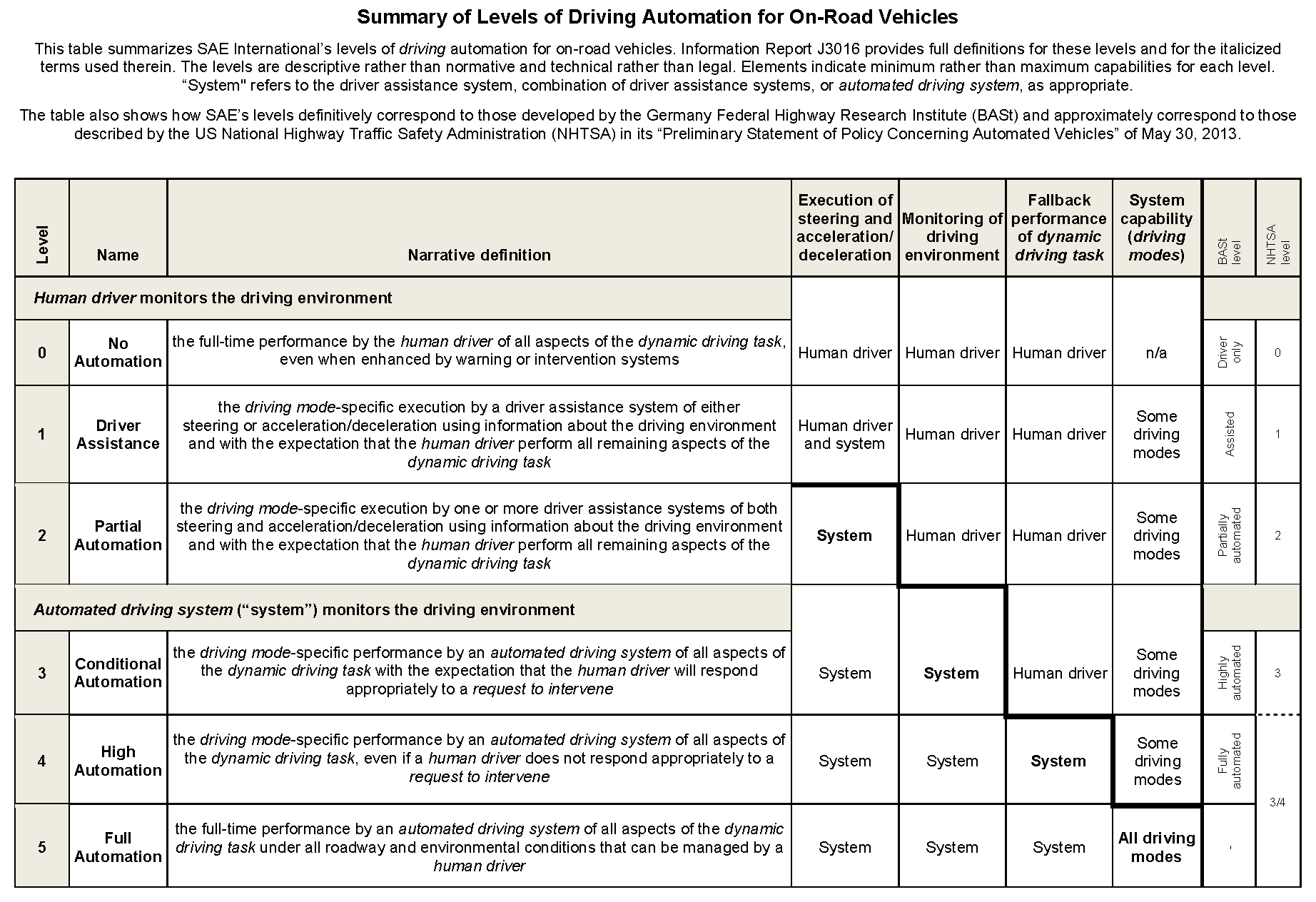
(Source: http://cyberlaw.stanford.edu/blog/2013/12/sae-levels-driving-automation)
Technical knowledge required for fully automated driving
As indicated in the autonomous driving levels, the technology for "control" and "system" is required for the realization of fully automatic operation. The technologies related to fully automated driving and its investment ratio are shown Figure
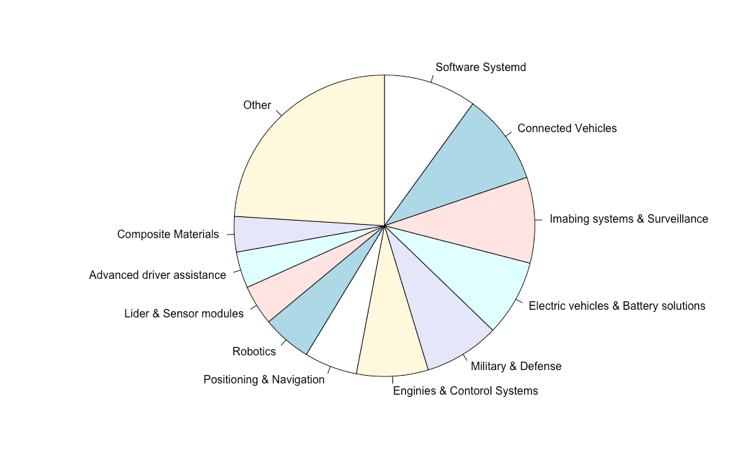
Thus, it can be seen the circumstances that the investment in technologies related to "software and control" are high. The control system is more important than the vehicle in itself in the automatic driving field. There is “IoT” in ICT industry. IoT is a technology that acquires information with sensors, stores data in the cloud, analyzes the data with artificial intelligence, and then activates the results. This technology can be applied to automatic driving. Because "prediction, recognition and judgment" are required to operate the vehicle, and these are controlled by software. A concrete representation of the technology required for such operations are shown in Table
The process of operating automatic operation by these technologies is as follows:
Measure using GPS
Create a local dynamic map that integrates the map information and the information read by the sensor. After recognizing the driving environment and the destination, the artificial intelligence module understands the environment and makes decision to correct the target driving.
Perform actual speed control and steering control based on the information from the artificial intelligence module.
This process also requires big data analysis including not only road and traffic information such as inter-vehicle distance and white line distance but also traveling environment sensing and obstacle recognition.
Research Questions
This paper focuses on firm’s R&D activities in autonomous vehicles. The differences of R&D patterns on automobile manufacturers, parts suppliers and ICT companies are indicated using patent information with patent map and HITS algorithm. Our research questions are first, as we classify these companies as automotive manufacturers, automotive suppliers, and ICT companies, whether there are the significant differences between R&D patterns of these three industries, or not. Second, whether there are the significant characteristics of technological development and changes in core technology in these three industries. So, we can find the changes of R&D activities by analyzing the changes of patent information.
Purpose of the Study
CASE is a topic of automotive manufacturers, automotive suppliers, and ICT companies. R&D activities in autonomous vehicles are increasing in the world. Autonomous vehicles consist of autonomous recognition, judgment, and operation. Autonomous vehicles are one of traffic accident preventing equipment. Also, another purpose of autonomous vehicles is for counter traffic congestion. First, regarding traffic accident preventing, autonomous recognition, judgment, and operation means exclusion of human errors, which are major reason of traffic accidents. So, it contributes traffic safety. Second, regarding counter traffic congestion, autonomous vehicles can accurate operation even on alley. It contributes for counter traffic congestion. R&D activities in autonomous vehicles are increasing in the world, so autonomous vehicle technology concern to international competitiveness. Japanese government aims to reducing a senior driver's crash risk. So, Japanese government promotes the adoption of "safe driving support cars," vehicles equipped with advanced safety technology, such as automatic braking systems. The number of companies focused on autonomous vehicle technology, and autonomous vehicle technology is advancing quickly through the 2010s. Autonomous vehicles are products of the highly developed computer science, such as AI. So, strategy of these companies will concern to autonomous vehicle technology. Therefore we analyze and consider the R&D project structures of these companies reported as important in technology development using patent information that is considered to indicate technology development capabilities in this paper.
Research Methods
Patent Information and Patent map
Patent documents are an ample source of technical and commercial knowledge. The patent is one of the indicators of capacity for technological development. There are some researches aimed at visualizing and analysing patents, or proposing efficient text-mining approaches for creating patent maps (Arai, 2003; Chen et al., 2018). Therefore, patent information is used as indicator of R&D capability in this research. All Japanese patent information is managed in the Patent Information Platform (J-PlatPat) operated by the Japanese Patent Office and everyone can search, browse and download the patent information. All patents are classified according to each of three classification codes, IPC (International Patent Classification), FI (File Index) and F-term (File Forming Term). In this research, all patent publications related to autonomous vehicle based on both of following conditions from 1990 to 2015 are collected, as in the case of previous research.
((AUTONOMO+ AND CAR) OR (UNMAN+ AND VEHICLE) OR (DRIVERLESS AND (CAR OR VEHICLE)) OR (SELF-DRIV+ AND (CAR OR VEHICLE)) in Claim
B60W in IPC code
There are following three ways to analyze patent information.
Quantitative analysis: An analysis method to grasp patent information as the number of applications, the number of inventors, the number of keywords, etc.
Qualitative analysis: A method of analyzing patent information based on the technical content.
Correlation analysis: A method to analyze the existing relationship between patent information.
End product manufactures, component suppliers and the ICT industry have entered the automated driving industry. Therefore, we investigate trends in the number of patents and technology development by each industry using heat maps and changes of core technology using HITS algorithm in this research. Specifically, we will clarify the characteristics of technological development and changes in core technology in these three industries. The list of companies in each industry is shown in the Table
HITS Algorithm
The HITS algorithm is a method to extract highly important information by performing link analysis (Kleinberg, 1999). The Authority indicates what has important information and the Hub, and the Hub indicates what is linked to the Authority. The Authority Score and Hub Score are extracted by repeating the following equations.
In the above equation, q means the score before the evaluation, and p means the score after the evaluation. Therefore, there are relation that a good authority is linked by multiple good hubs, and a good hub is linked by multiple good authorities. In this research, we apply this HITS algorithm to a patent citation network to extract core technologies that are attracted attention from other companies in the industry.
Findings
An Approach Based on the Number of Patent Publications
As our first approach, the numbers of patent publications related to R&D of autonomous vehicle in Japan and U.S. are shown in Figure
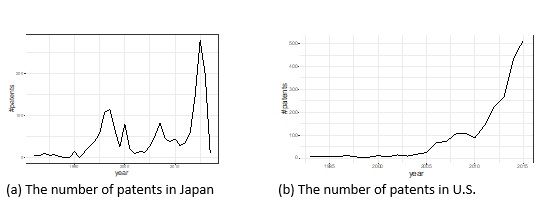
The number of applications for Japanese patents increased around 1997 and then decreased, but it can be seen that the number of patents increased sharply with the development of AI and image processing technology in 2015. Looking at the change in the number of English patents, it can be seen that the number has gradually increased since around 2005, and has grown rapidly in recent years. By these figures, it can be understood that interest in automatic vehicle development has increased.
An Approach Based on the Research Fields
Research Fields in Japanese Patent
Heat maps that is represented the R&D fields based on patents by each industry in Japan are shown in Figure

Research Fields in U.S. Patent
Heat maps that is represented the R&D fields based on patents by each industry in U.S. are shown in Figure

An Approach Based on the Core Technology
Autonomous Level of Core Technology
The automatic operation levels of the top 30 core technologies in every year that is applied HITS algorithm to citation network are shown in Figure
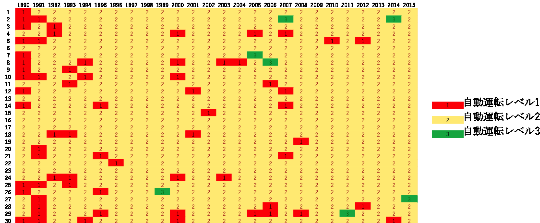
Transition of Leading Companies
The trends in the number of patents by each industry in the top 30 major technologies are shown in Figure
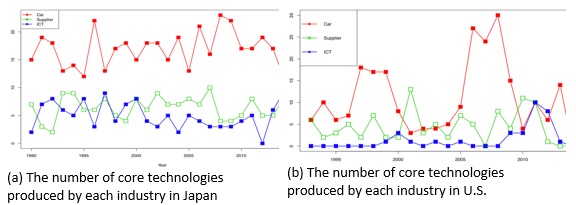
Discussion
Autonomous vehicle technology involves various technologies. So, not only companies of automotive manufacturers, but also automotive suppliers, and ICT companies can be major in certain areas of autonomous vehicle technology. Using HITS algorithm, we find most of the top thirty companies of automotive driving patent ranking are automotive manufacturers. Autonomous vehicle technology involves not only automotive technologies, but also various technologies. But it is said that the most major cost of building cars is factory of automotive manufacturers, not materials. And for development of products, technological development of manufacturing is needed. So, even in era of autonomous vehicles, the importance of technology of automotive manufacturers will be still high.
Conclusion
We analyze and consider the R&D project strategies of these companies by using patent information. First, our line graph shows R&D activities in autonomous vehicles are increasing recently. Second, our heat map about R&D activities in automotive manufacturers, automotive suppliers, and ICT companies shows R&D activities in automotive manufacturers are wide. Third, since 2000, R&D activities of 3D241(related to control of drive devices and motor control of vehicles) in these three industries are lively. Fourth, using HITS algorithm, we find most of the top thirty companies of automotive driving patent ranking are automotive manufacturers. Fifth, since late 1990s, R&D activities in automotive suppliers and ICT companies are lively. Finally, R&D activities in ICT companies once have declined, but since 2015, R&D activities in ICT companies are lively. For further study, we analyze and consider the cooperation between industries and companies.
Acknowledgments
This work was supported by JSPS KAKENHI Grant Numbers JP17K18571 and JP18K04629.
References
- Arai, K (2003). Patent information analysis and patent map. Information Science and Technology Association, 53(1), 16-21. [in Japanese]
- Chen, Y., Park, Y., & Nakaoka, I. (2018). A Comparison Study on the Vertical Integration and Horizontal Specialization of Chinese ICT Companies. Journal of Robotics, Networking and Artificial Life, 4(4), 317-321.
- Kleinberg, J. M. (1999). Authoritative sources in a hyperlinked environment. Journal of the ACM, 46(5), 604632.
- Osawa, R., & Nakamura, Y. (2015). A computer approach to highlight unrecognized knowledge for development of safe and reliable autonomous car system - mapping emergent situations. IPSJ SIG Technical Report, 2015-ICS-180(3), 1-6. [in Japanese]
- Suda, Y., & Aoki, K. (2015). Current activities and some issues on the development of automated driving. Journal of Information Processing and Management, 57(11), 810-811. [in Japanese]
Copyright information

This work is licensed under a Creative Commons Attribution-NonCommercial-NoDerivatives 4.0 International License.
About this article
Publication Date
06 October 2020
Article Doi
eBook ISBN
978-1-80296-087-7
Publisher
European Publisher
Volume
88
Print ISBN (optional)
-
Edition Number
1st Edition
Pages
1-1099
Subjects
Finance, business, innovation, entrepreneurship, sustainability, environment, green business, environmental issues
Cite this article as:
Nakaoka, I., & Akaoka, H. (2020). R&D Activities In Autonomous Vehicles Using Patent Information. In Z. Ahmad (Ed.), Progressing Beyond and Better: Leading Businesses for a Sustainable Future, vol 88. European Proceedings of Social and Behavioural Sciences (pp. 1058-1067). European Publisher. https://doi.org/10.15405/epsbs.2020.10.99
